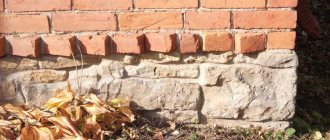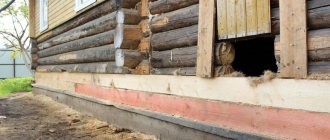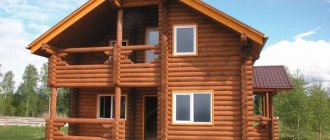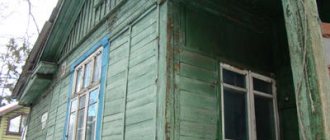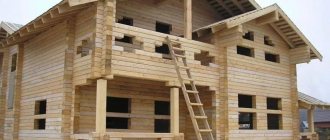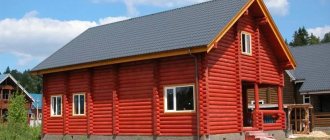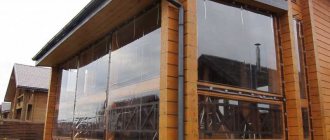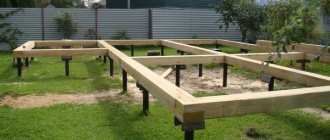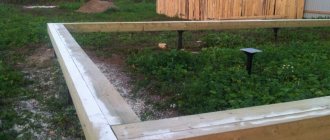The main advantages of a strip foundation are high load-bearing capacity, strength, resistance to all loads with a minimum amount of building materials.
This combination of qualities rightfully makes the tape a leader among all other types of supporting structures.
At the same time, the tape is constantly exposed to multidirectional loads from the soil and influences from the weight of the building, snow, wind loads, etc.
Situations often arise when the strength of the tape is at its limit, especially when seasonal ground movements occur.
Such cases necessitate strengthening the tape, which must be discussed in detail.
Reasons for the destruction of strip foundations
The strip foundation constantly experiences destructive influences.
These include:
- Frosty soil heaving.
- Soil subsidence.
- Construction or excavation work taking place nearby.
- Seasonal ground movements.
- Floods, changes in groundwater levels.
- Presence of slope.
In addition, negative consequences can be caused by:
- Low quality building materials.
- Failure to comply with technological requirements during construction.
- Change in the weight of the building caused by the construction of an additional floor or other reasons.
- Violations of house operating rules.
The listed impacts can occur either individually or in combination, which creates extremely difficult operating conditions for the foundation.
Over time, concrete begins to lose its strength, and additional stress accelerates the destructive processes many times over. The solution to the problem may be to strengthen the strip foundation .
Another way
Slightly different technology can also be used to strengthen the foundations of very old buildings. In this case, a trench is also dug around the perimeter of the house to the depth of the foundation. Next, with a certain step, through niches are cut out in the upper part of the foundation strip.
At the next stage when repairing the foundation of an old building:
- a reinforcement frame is installed in the niches and connected to the main one;
- niches are filled with concrete;
- after the concrete has matured, parts of the old foundation located directly under the filled niches are removed;
- Under the resulting concrete blocks, fixed to the foundation frame, metal telescopic piles are installed.
When is amplification required and what is it?
The need to strengthen the foundation arises in different situations:
- When it is planned to build an additional floor, an extension, or otherwise change the size of the house.
- When cracks appear on the walls or foundation strip.
- If the waterproofing of the tape is broken, causing the concrete to crumble.
- Mechanical damage to the tape.
- Rising groundwater levels destroying the tape.
- Aggressive environmental influences.
All these cases require immediate intervention. Reinforcement is an increase in the load-bearing capacity of the strip base by installing additional elements, increasing the cross-section of the strip, injecting special substances or other measures.
The choice of a specific method depends on the condition of the belt, the cause of the problem and the extent of the intervention required. In any case, before starting work, it is necessary to thoroughly examine the structure and make a decision with the participation of experienced specialists.
NOTE!
Self-indulgence in such matters is absolutely excluded, since instead of the expected results, you can get exactly the opposite consequences.
Recommendations from experts
When wondering how to strengthen a monolithic slab or strengthen a slag-filled foundation, you should take into account certain conditions:
- It is possible to reduce the pressure on a foundation with weak concrete by reducing the level of heaving in the soil composition. For this purpose, a sand cushion is laid under the supporting structure, around which a clay belt is placed;
- The ability of the soil to move will be significantly reduced if drainage is installed around the foundation. This will have an impact on the increase in the density of the soil composition, which will increase the strength of the foundation for a slag-lite or other house;
- an insulating layer installed in the basement and on the foundation will significantly stop destruction and extend the operational period;
- The foundation will be protected from the effects of precipitation by sealing the abutment areas on the blind area. You can reduce the level of moisture entering the ground during rain by using gutters located on the roof structure.
To properly strengthen the foundation structure, you must take into account the advice of professional craftsmen. They argue that when choosing a method for strengthening the base, one should take into account the condition of the object, its characteristics and reconstructive capabilities.
If settlement is complete, then you can limit yourself to sealing cracks using cement mortar. If the process is strong enough, you will have to establish its cause, and only then take appropriate measures. For example, if the deformation process is caused by soil washing out, then a concrete mixture is pumped into the resulting void areas. This option perfectly strengthens the base and increases its waterproofing properties.
To strengthen the foundation of a garage and other shallow strip foundation, builders use screw, bored or drilled pile supports. Unfortunately, installation work is most often done manually.
Each option for strengthening a block or other foundation is developed taking into account the results of research and design data. Owners of private houses should remember that such work can be done on their own, but requires a preliminary thorough examination by experienced specialists.
Diagnosis of the problem
Diagnostics is a set of measures aimed at obtaining complete information about the condition of the supporting structure, the presence of mechanical damage, cracks or deformations.
The condition of the underlying soil, sand cushion and other elements that bear the load from the weight of the house is examined.
The procedure is carried out in stages:
- External inspection of visible parts of the tape . Visual detection of tape damage is carried out from the outside, from the basement (if possible). Looks for visible signs of problems with adjacent layers of soil - subsidence, gullies, etc.
- Underground inspection . The tape is dug around the perimeter, the condition of the trench is checked, the surface of the tape is inspected and any damage that has occurred is detected. The immersion depth of the tape and the base material are assessed.
A defect report is drawn up, which includes all detected damage. A foundation plan is drawn up , on which points of damage, cracks, and deformed areas are noted.
Based on the documentation compiled, a decision is made on measures to solve the problems that have arisen.
During these works, a monthly check of the belt immobility is carried out . Special control beacons are installed on the surface and their condition is recorded.
After a month, their position is checked. If there are no changes, it means that the tape has completed settling.
To perform complex work, unloading of the foundation is required . Its purpose is to transfer the weight of the house to an auxiliary support system, allowing the soil under the tape to be removed for replacement or waterproofing.
Application of piles
Next, we’ll look at how to strengthen the foundation of an old house with your own hands using this technology. This technique is somewhat complex. Therefore, strengthening with piles is usually entrusted to specialists. However, if you have some experience in construction, you can try to carry out a similar procedure yourself.
When using this technology:
- strengthen the corners of the foundation of the house;
- holes with a diameter of 250-300 mm are drilled around the house;
- formwork made of plastic or steel pipes or simply rolled up roofing material is inserted inside the holes;
- The bottom of the recesses is compacted and a sand cushion is poured onto it;
- a reinforcement frame is mounted inside the formwork, connected from several vertical rods using clamps;
- The piles are filled with concrete.
The owner of a suburban area who decides to strengthen the foundation in this way, among other things, needs to know how to strengthen the corners of the foundation of the house correctly. In order to do this, excavations are first made in the right places. Next, the foundation is cleared of soil from below and on the sides. Then metal piles are installed at the corners under the tape and reinforcing rods are welded to them. After this, concrete pads are poured at angles.
At the final stage, when using this technology, the manufactured support piles are connected to each other with a grillage. At this point, the reconstruction of the foundation and its strengthening can be considered complete.
How to strengthen a strip foundation
The actions that need to be taken to strengthen the tape are determined by the size and causes of the damage. In some cases, it is enough to update the waterproofing ; in other situations, a set of complex technical measures is required, such as installing additional supports or expanding the tape.
Let's take a closer look at these methods:
Strengthening a shallow foundation with a concrete jacket
A concrete jacket is a reinforcing concrete casting installed on a problem area of the wall.
To create it, perform the following steps:
- The surface of the tape is exposed, and all soil in the problem area is removed from the trench.
- The waterproofing layer is removed from the concrete tape. The surface of the material must be absolutely clean, as after pouring.
- Transverse holes are drilled through the tape into which reinforcing bars are inserted.
- A reinforcement frame is knitted and welded to rods inserted into the holes of the tape.
- The formwork is being installed.
- Concrete is poured and left for the required time.
- After the curing period has expired, the formwork is removed, the concrete surface is waterproofed and further actions are carried out.
The dimensions of the reinforced concrete jacket depend on the size of the damaged area, but not less than 1 meter.
Creating a concrete frame
The concrete collar forms an additional layer of material on both sides of the tape. The technology resembles the method of installing a reinforced concrete jacket , but an additional layer is poured on both sides of the problem area of the tape.
All actions are carried out both inside and outside the tape . As a result, a significant thickening of the foundation is formed , capable of withstanding high loads.
IMPORTANT!
Many experts express distrust in installing clips. They argue this by the lack of a qualitative connection between the old concrete and the new casting. The processes occurring in fresh material do not allow the layers to join together properly, so the technique is suitable only in the presence of relatively minor damage.
By using piles
The method of strengthening with piles is quite complex and varied. Piles are being installed to create additional support for the tape. They rest on dense layers of soil, stopping subsidence or increasing the bearing capacity of the foundation to accommodate increased loads from extensions or new structural elements of the house.
Different types of piles are used:
- Micropiles.
- Pressable.
- Bored.
- Screw.
- Remote.
Each type of pile performs its own function and is used in certain situations where their use is the best solution to the problem. Thus, screw piles can be installed manually using the most gentle methods possible.
Pressed-in piles require the use of special equipment, so their use for reinforcement is limited.
External piles are installed at some distance from the perimeter of the old tape, then metal beams are passed through it and connected to the piles. As a result, the house appears to be “suspended” on the beams, receiving additional support .
The weight of the building is distributed between the old and new foundations, which allows it to bear increased loads.
With the help of tides
The technique is used to strengthen a tape made of piece elements - brick or rubble stone. The ebb tides are designed to perform the functions of an armored belt .
They are installed on the surface of the tape on both sides, pressed out so that the upper part does not contact the surface of the wall, and the lower part is pressed against it as tightly as possible.
After this, the structure is firmly fixed using jacks. A trench is dug to form a form for pouring concrete. As a result, an additional reinforced concrete layer is formed around the tape, enhancing the load-bearing capacity and strength of the base .
Strengthening with shotcrete
Shotcrete is the process of applying concrete using a special spraying method . Special equipment is used for this. The essence of the method is to supply a dry mixture of cement and sand, called a gunite mixture, under compressed air pressure.
Simultaneously with the supply of the mixture, water is supplied from another tank to mix the mixture. As a result, a layer of dense and durable concrete appears on the reinforced surface , which has improved characteristics compared to conventional types of material.
NOTE!
The technology is complex and requires the involvement of specialists and the use of sophisticated equipment.
Strengthening using blocks
This method is considered technologically even somewhat more complex than the one described above. However, using this technique, it is possible to make an even more reliable strengthening of the foundation. In this case, in the corners of the building, excavations are first made directly under the base.
Next, in these places, thick support cushions are poured from concrete. The next step is pouring a new reinforcing tape according to the method described above. When using this technology, the pillows and the new reinforcing foundation are additionally connected by a reinforcement cage.
Stopping the subsidence process
Shrinkage is a natural process. However, when the work is carried out correctly, it occurs unnoticed and does not lead to consequences in the form of distortion of the structure and the appearance of cracks. When the foundation sank, negative manifestations of the shrinkage process appeared, so it is necessary to raise and strengthen the supporting structure of the house, then the initial action should be to stop the subsidence process.
To establish the shrinkage rate, beacons (plaster or paper) are glued to the crack that appears. If the settled foundation continues to rapidly deform, then the beacons will also quickly collapse.
When it is determined that the foundation has subsided very quickly, then actions to restore it should begin promptly. To prevent the process, the following steps should be taken:
- Dig a hole with a 35˚ slope directly next to the base of the house.
- Place an asbestos-cement or metal pipe (diameter 15-20 cm) into the hole.
- Pour concrete or cement mortar over it, pouring it until the ground can absorb it.
- Take a break for a couple of hours, monitoring the condition of the remaining solution - whether they are absorbed by the earth or not.
- If the concrete is completely absorbed by the soil, then the next pour can be done in a day.
- To ensure good saturation of the soil under the foundation of the house, the actions are performed several times. Finally, a few days after the last filling, the beacons are installed again and checked for destruction. If they tear, then you need to continue pouring the solution.
This approach allows you to effectively strengthen the existing support of housing construction. Next comes the process of strengthening the structure:
- the old foundation is surrounded by a dug ditch (trench) 20-35 cm wide;
- formwork boards are laid along the bottom of the ditch from the edge of the outer side;
- between the elements, strong metal pins are driven into the support, onto which the mesh is attached;
- the design resembles reinforcement poured with concrete.
The use of such reinforcement of foundations allows you to correct the bearing capacity of the foundation of the house, distributing the load horizontally. This will prevent further subsidence. However, if the corner of the building has sagged, it may be impossible to lift it yourself. It is better to seek help from specialists.
Why does damage occur?
There are several reasons why the foundation begins to collapse and needs to be strengthened.
Strengthening the foundation of a house
Here experts highlight the following factors:
- the building is dilapidated and all phenomena are due to the time of operation;
- mistakes were initially made during the design;
- during the process of laying the foundation, technology was violated;
- additional extensions were added, which affected the strength of the structure;
- the original state of the soil has changed, the level of underlying groundwater has increased due to prolonged and heavy rainfall;
- the area around the building was built up with other structures;
- communications were laid, which was accompanied by serious earthworks;
- unforeseen redevelopment that took its toll;
- an improperly organized drainage system caused the house to be washed away;
- blasting operations or the close location of the building to the road led to strong ground vibrations;
- the heavy weight of a brick house destroys the foundation, which needs strengthening.
There are more than enough options.
Before carrying out further strengthening work with your own hands or with the help of craftsmen, you need to understand why this happened. This will help you choose the best way to strengthen the damaged structure.
Installation of reinforced concrete frame
This method of increasing strength is especially in demand in cases where it is not necessary to deepen the sole. The volume of excavation work will be minimal; concreting can also be done on your own, without involving specialists.
New support blocks - clips, are connected to the old tape with reinforcing bars. They are driven into the foundation structure. After this, the reinforcing belt is woven into the new frame, the formwork is installed, and concrete is poured. After it hardens, you can proceed to backfilling the soil.
